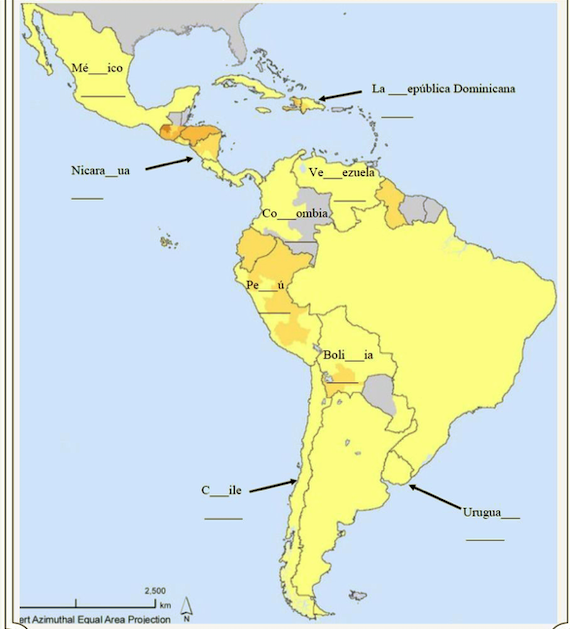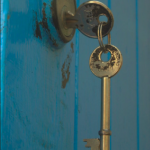Pronunciación
Pronunciación
The Spanish Alphabet – El Alfabeto (ABCdario)
There are 27 letters in the Spanish alphabet, including “ñ” and “rr.” All the letters are pronounced with the exception of the letter “h,” which is silent before any vowel but is pronounced when accompanying the letter “Ch.”
Letra |
Nombre |
Ejemplo |
Pronunciación |
| A | a | Agua | Ah |
| B | be | Bien | |
| C | ce | Casa, cinco | C + a, o, u (strong sound) = “k” C + e, i (soft sound) = “s” |
| D | de | Días, perdón | “D” sound is soft between two vowels |
| E | e | Encantada | “eyh” |
| F | efe | Filosofía | |
| G | ge | Geografía, gusta | G + a, o, u (strong sound) =”guh” G + e, i (soft sound) =”huh” |
| H | hache | Hola | The h is SILENT (unless it is a ch) |
| I | i | Idioma, inglés | “ee” sound |
| J | jota | Jalapeño | Makes the same sound as the English “H” |
| K | ka | Kilo | |
| L | ele | Luego | |
| LL | elle | Me llamo | Double L makes a “Y” sound |
| M | eme | Mesa | |
| N | ene | Nada | |
| Ñ | eñe | Español | Makes the sound that you hear in “onion” |
| O | o | Otoño | |
| P | pe | Permiso | |
| Q | qu | Queso | “Q” — which always appears in combination with the letter “u” — is pronounced like the “k” in the word “kid” |
| R, RR | ere, erre | Pero, perro, Rosa | “r” sounds like the “dd” in words like “ladder” When the “r” is the first letter of the word, it is trilled like the “rr” |
| S | ese | Saludes | |
| T | te | Tengo | |
| U | u | Universidad | “oo” sounds like “boo” |
| V | ve | Vamos | “B” sound, some countries a little softer |
| W | doble u, doble ve | Wilson | |
| X | equis | Examen | “KS” sound, like “ek-samen” |
| Y | i griega, ye | Yo | |
| Z | zeta | Zapatos | “S” sound (except in Spain -th-) |
The Spanish Vowels: Las vocales
|
| It is helpful to pronounce each vowel well. There is only one way to pronounce them.
A- ah E- eyh I- ee O- o U- oo |
ACTIVIDAD #1
Please read out loud the following words, paying special attention to the vocalic sounds and stress. In case there is a written accent over the vowel, place more emphasis on that syllable:
| clase | español | universidad | cuaderno | niño hombre |
| buenas | libro | computador | José | Estados Unidos |
| hospital | perro | pero | nada | agua acá |
 ACTIVIDAD #2
ACTIVIDAD #2
¿Cómo se escribe? Work with a partner and take turns to ask how to spell each other’s names.
| Pablo Neruda ⇑ ⇑ nombre apellido Se escribe: pe-a-be-ele-o Se escribe: ene-e-ere-u-de-a |
Example:
E1: ¿Cómo se escribe tu (your) nombre?
E2: Se escribe _____________________
E1: Y (and) ¿cómo se escribe tu apellido?
E2: Se escribe _____________________.
E1: Perdón, ¿puede repetir, por favor?
E2: se escribe ______________________.
ACTIVIDAD #3
APODOS. Here are the most common Spanish nicknames. Can you match them with the first name? Guess as many as possible before you check with a classmate or the internet.
| 1. | Antonio | a. Paco |
| 2. | Ignacio | b. Fonsi |
| 3. | Alejandro | c. Toño |
| 4. | Mercedes | d. Chayo |
| 5. | Alberto | e. Chuy |
| 6. | Guillermo | f. Alejo |
| 7. | José | g. Memo |
| 8. | Rosario | h. Merche |
| 9. | Francisco | i. Beto |
| 10. | Jesús | j. Pepe |
| 11. | Guadalupe | k. Nacho |
| 12. | Alfonso | l. Lupe |
NicknamesIn the Spanish-speaking world, nicknames can sometimes seem harsh or even offensive. It is not offensive (generally) to refer to someone based on a physical characteristic.For example,Flaco, flaca, gorda, gordo, guero, guera, pelón, viejo. |
ACTIVIDAD #4
La geografía. Fill in the blanks with the missing letter from the Latin American countries below. Then spell it out.

La __epública Dominicana
Nicara__ua
Ve__ezuela
Co__ombia
Pe__ú
Boli__ia
C__ile
Urugua__
Actividad adapted from: Libro Libre: Beginning Spanish CC BY-NC-SA 4.0
ACTIVIDAD #5
Pronunciación. Analyze the pronunciation of C and G and underline the odd one in each group.
1. C: Ecuador Costa Rica Cuba Valencia
2. C: Tegucigalpa Canadá Ciudad de México
3. C: Colombia Barcelona Rebública Dominicana
4. G: Guatemala Gibraltar Cartagena Girona
5. G: Argentina Paraguay Nicaragua Uruguay


